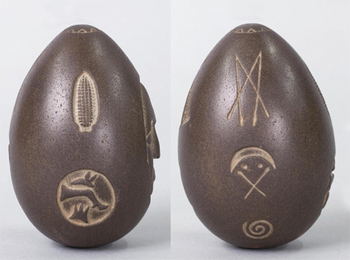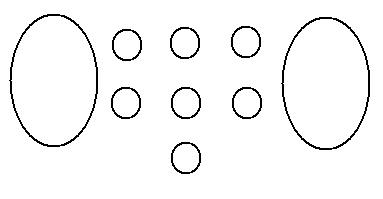– B.L. Freeborn, July 2012, updated Sept 2022
 This small artifact is on display in the New Hampshire Historical Society in Concord. Found in 1872 near Lake Winnipesaukee, its origin remains unclear. Its meaning alludes traditional translation. The only explanation for its symbols and purpose that I have found is that it represented a treaty between two tribes. The first time I saw it, this explanation was satisfactory. Sometime ago I had another look at it and now think this is incredibly old and an object once owned by a person of great importance. It was the simple ear of corn that finally made me exclaim in awe as it yielded up the stone’s secret.
This small artifact is on display in the New Hampshire Historical Society in Concord. Found in 1872 near Lake Winnipesaukee, its origin remains unclear. Its meaning alludes traditional translation. The only explanation for its symbols and purpose that I have found is that it represented a treaty between two tribes. The first time I saw it, this explanation was satisfactory. Sometime ago I had another look at it and now think this is incredibly old and an object once owned by a person of great importance. It was the simple ear of corn that finally made me exclaim in awe as it yielded up the stone’s secret.
A study of this artifact proves it to be a truly magnificent and complicated work of art. This small stone is of a noble nature and its message is vastly important.
It is a mere 4 inches in height and has a diameter of only 2 ½ inches. Onto this small surface ten images are carefully carved. The stone is made of quartzite or mylonite. The surface is smooth and polished. If it was a naturally occurring stone that was utilized by the artist, then he was fortunate in his find and with his skill. The art is flawless except for a chip near the forehead of more recent appearance. The work is intricate and detailed. The proportions are perfect for the message, so if the artist had faltered he would have had to find another stone of equal ellipsoid perfection. This suggests the stone was turned and then polished to the desired proportions.
The fact that it was probably turned leads most experts to quickly conclude it is of 19th century origin. This would be thinking only within the known context of our accepted knowledge of history. Consider that we cannot explain the construction methods of some of the oldest sites to be found in the world. The debate as to how the Great Pyramids were built still rages. The explanation as to how stones can be cut and fit as perfectly as they are at Machu-Picchu alludes us. Into this class falls this perfectly cut stone. We have two options open. It is either 19th century or extremely old.
The idea that it is 19th century is problematic to start. This was first machined before it was decorated. The symbolism is of tents, corn and arrows. Hence, we quickly conclude it was not colonial in nature but tribal. How many tribes had lathes or turning equipment? So then we conclude it is early American art of a unique nature. But that does not seem either satisfactory or logical. If the symbolism could be understood, then we might understand its origin.
On the front panel a large face is cut. On its left side are 2 small symbols, on its rear are 3 and on its right are 2. This comprises 7 small images. On its top is a circle with 8 triangles and a 1/8 th inch bore hole. On the bottom is a circle with 8 triangles tacked on. There is a 3/8 inch bore hole in the bottom. This then creates 10 images upon the stone. Its circumference calculates to 7.9 inches. The layout appears in the sketch.
We shall look at each image individually in separate posts. (Afterwards, the entire ten posts will be repeated as one complete document.) Before we begin, we look at it overall and see there is in this array of images the following number sequence. The face = 1, then 2 images, then 3 images, then 2 images, and then the face = 1. Or 1, 2, 3, 2, 1
12321
The square root of 12321 is?
111 exactly.
And 111 can be said to represent God.
Consider that there are 7 images in the back grouping which reaffirms the special number 7. Add to this the two images on top/bottom and obtain 9. And then the face makes ten or we have these numbers in series 7, 9, 10 or 7910. The circumference of the object is 7.9 inches. We know this number today as the diameter of the Earth at 7920 miles. This object is an oblate sphere. The Earth is an oblate sphere. This object has circular areas on the top and the bottom just as Earth has circular areas on the top and bottom called the polar ice caps.
The array of seven scenes if read as rows becomes a series of numbers: 3, 3, 1 or we might say 33.1. This number represents an important concept I explain in numerous posts in the future. It represents an extremely significant idea portrayed repeatedly in the Ancient World.
It is easy to imagine the person depicted lived in a cold climate since it appears he is wearing a hood. This is emphasized by two small etched lines as if there are shoulders shown below the face. So the place from which this came was likely cold. The face is serene and silent, almost sad. It is beautiful and perfect in its proportions. Is this not a statement that says, “We were a beautiful and contemplative people” ?
 So, I leave you to contemplate the truth and the possibilities….
So, I leave you to contemplate the truth and the possibilities….
More to follow…………….next the top and bottom images are examined as we decipher the Mystery Stone.


very cool
Thanks for showing more of this head. Incredible! Is that the Akhet I see? The X with the eyes and crescent Moon over its head. In the UK they used a big bird, here we have the Moon. X marks the spot, the Sacred Place.
X does mark the spot and more.
You mention that this may have been made on a lathe. There are vases in Egypt made of stone. They are so perfect and so thin walled, that the experts think they may have been made on a lathe, which leaves the archaeologists scratching their heads……again. This stone is much the same shape as an Egyptian mace head. The “arrows”? not sure they are arrows, have seen this symbol before, but can’t remember where. I’ll have to look through my upstairs.
A lathe is a relatively simple idea. It is reinvented repeatedly.
The ‘arrows’ in this form- have been found in Europe.
Interesting!
It’s beautiful!
Thank you. You may want to see the full post at https://noahsage.com/new-hampshire-mystery-stone-of-lake-winnipesauke/